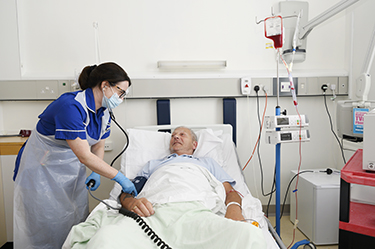What is a stem cell or bone marrow transplant?
You might have a stem cell or bone marrow transplant as part of your cancer treatment.
It is a treatment for some people with:
- lymphoma - cancer of the lymphatic system
- leukaemia - cancer that develops in the white blood cells of the immune system
- myeloma - cancer that develops in white blood cells called plasma cells
- myelodysplastic syndromes (MDS) - a group of blood cancers where the bone marrow doesn’t work properly and makes abnormal blood cells.
It is also a treatment for other blood conditions.
A transplant allows you to have high doses of chemotherapy and other treatments. The stem cells are collected from the bloodstream or the bone marrow.
What are stem cells?
Stem cells are very early cells made in the bone marrow. Bone marrow is a spongy material that fills the bones.

These stem cells develop into 3 different types of blood cells. They are:
- red blood cells - contain
haemoglobin  and carry oxygen around the body
and carry oxygen around the body - white blood cells - part of your
immune system  and help fight infections
and help fight infections - platelets - help clot the blood and stop bleeding

How do transplants work?
Before your transplant, you have conditioning treatment. Conditioning treatment usually includes chemotherapy and you might also have:
- targeted cancer drugs
- radiotherapy to your whole body (called total body irradiation or TBI)
Conditioning treatment aims to kill cancer cells. But it also kills the stem cells in your bone marrow. To prepare for your transplant, your team either collect:
- your own stem cells
- or a donor's stem cells (donor transplant)
After the treatment, you have the stem cells into your bloodstream through a drip. The cells find their way to your bone marrow where they start making blood cells again. Your bone marrow slowly recovers.
You usually have high dose conditioning treatment for a transplant using your own stem cells.
Conditioning for a donor transplant
There are different strengths of conditioning treatment for a donor transplant. The 2 main strengths are:
- full intensity (myeloablative) conditioning
- reduced intensity conditioning (RIC)
Full intensity conditioning (MAC)
Your doctor might also call this myeloablative conditioning or MAC. You have very high doses of treatment and all the cancer cells and healthy cells are destroyed.
Reduced intensity conditioning (RIC)
With RIC you have lower doses of treatment. Some healthy cells and cancer cells are left behind after treatment has finished. You might have RIC if:
- you are older (usually over 50 years)
- you are not fit or well enough for full intensity conditioning

What is the difference between a stem cell and bone marrow transplant?
The main difference is whether stem cells are collected from the bloodstream or bone marrow. A stem cell transplant uses stem cells from your bloodstream, or a donor’s bloodstream. This is also called a peripheral blood stem cell transplant. A bone marrow transplant uses stem cells from your bone marrow, or a donor’s bone marrow.
Stem cell transplants are the most common type of transplant. Bone marrow transplants are not used as much. This is because:
- it’s easier to collect stem cells from the bloodstream than bone marrow
- your team can usually collect more cells from the bloodstream
- blood counts tend to recover quicker following a stem cell transplant
You might have a bone marrow transplant if collecting stem cells has been difficult in your situation.
Why you might have a transplant
The aim of your transplant will depend on your situation. Your doctor might explain that a transplant will try to cure your disease or control it for as long as possible.
With lymphoma, leukaemia and myeloma the aim is to put the cancer into remission. Remission means there is no sign of the cancer.
Your doctor might suggest a transplant if your cancer:
- is in remission but is likely to come back
- has not responded to other treatments
Types of transplant
Depending on your situation, you might have a transplant using:
-
your own stem cells (autologous stem cell transplant)
-
or stem cells from another person (allogeneic stem cell transplant)
This page is due for review. We will update this as soon as possible.



